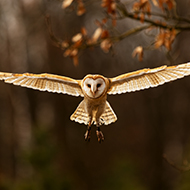Gliding barn owls could inform more aerodynamic design in aircraft

Researchers predicted the drag production for 16 gliding flights with a range of tail postures.
New research from the Royal College of Veterinary Studies (RVC) has shown that the tail postures of barn owls can be used to minimise drag.
Birds have always informed aerodynamic design in aeronautical engineering, and many aeronautical designs reduce the amount of drag by avoiding the use of the tail. However, the findings of the RVC's study suggest that certain positions of the tail could reduce drag and improve overall flight efficiency for smaller aircraft.
Published in the Journal of the Royal Society Interface, the study provided rigorous quantitative evidence of the avian tail in reducing drag by capturing video with 12 high-speed cameras of a barn owl gliding through an experimental flight corridor.
Using the footage, researchers were able to develop a comprehensive analytical drag model, calibrated by high-fidelity computational fluid dynamics (CFD). This model was then able to be studied to investigate the aerodynamic action of the barn owls' tails by virtually manipulating the posture of a gliding barn owl.
In observing postures in a variety of different contexts using the model, researchers discovered that by changing the position of its tail, a barn owl can minimise overall drag by using its tail for aerodynamic lift, and therefore reducing the lift needed from its wings.
Professor Jim Usherwood, corresponding author of the paper, commented: “The combination of a beautifully trained owl and modern methods of filming, surface reconstruction, computational fluid dynamics and a bit of new aerodynamic theory allowed us to approach a really ‘what if’ question.
“We were a bit surprised that the tail was producing so much lift for the gliding barn owl, but ‘what if’ she used the tail differently? Answer – there would have been a lot more drag!”



 BSAVA is to partner with BVA Live (11-12 June 2026) to champion clinical research.
BSAVA is to partner with BVA Live (11-12 June 2026) to champion clinical research.